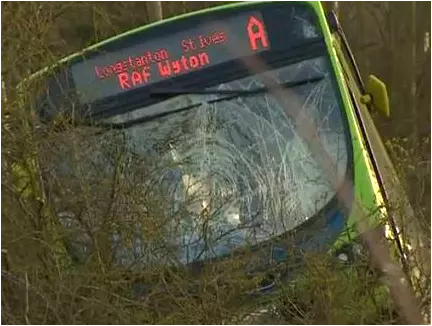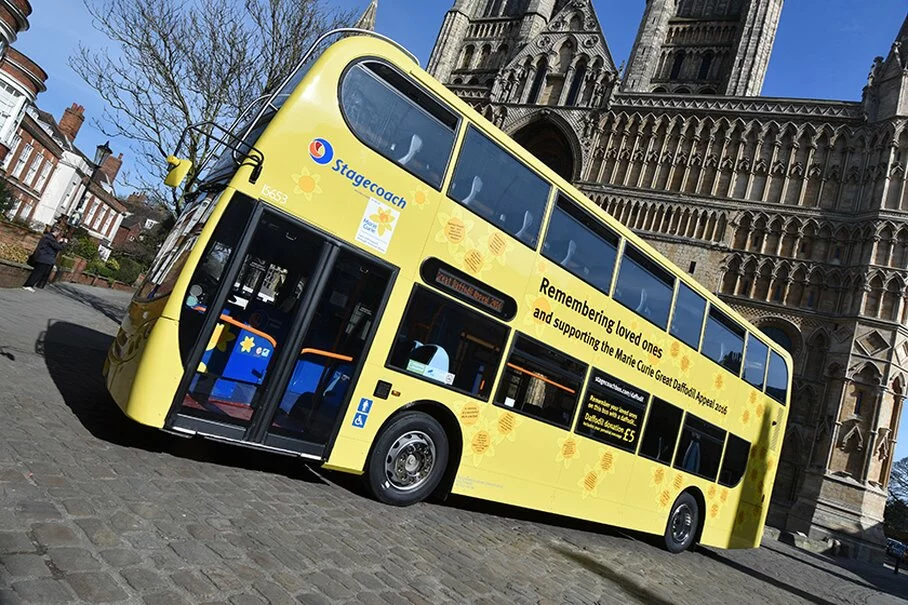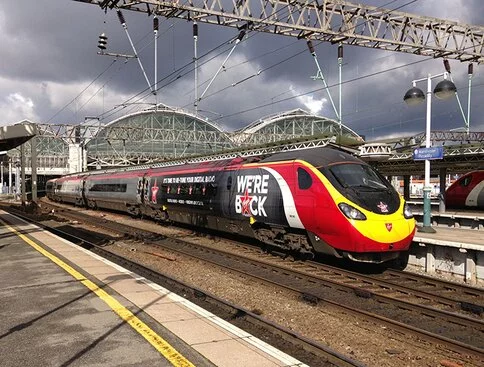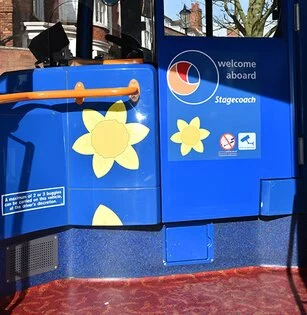- Home Page
- Fleet News Ramblings
- SKM News Views & Blog
- Behind The Picture
- Contact us
Stagecoach Skegness Fun Day30/3/2016 
Stagecoach East Midlands held a Fun Day in Skegness yesterday with Enviro 400 19169 Rocky and Volvo B7TL 16964 Rolly taking centre stage near the lifeboat station. The buses, which have become characters in their own right were there to promote the open top services and also help to raise money for charity during their appearance through the sale of children's story books which feature the open top buses.
During the day a donation was also made by Stagecoach of £1,000 to the Dreams Come True charity. Rolly was also offering tea ad cakes in aid of the charity. Other Skegness Seasiders were in service, including the last open top Volvo Olympian in the Stagecoach East Midlands fleet - 16314 Hattie. Pendolino becomes a radio star!30/3/2016  (c) Vrgin Trains (c) Vrgin Trains
The re-launch of Virgin Radio has been accompanied by the naming of Pendolino train.
The train, 390040, was formally named 'Virgin Radio Star' at Manchester Piccadilly station this morning. Following the naming there was music onboard. In a departure from the norm, for only the second time - the first was the X-Men Days of Future Past naming - the word Pendolino has been omitted from the nameplate. 390040 was formally named 'Virgin Pathfinder' The West Coast franchising merry-go-round gears up again23/3/2016 
It seems that whenever I speak with anyone from Virgin Trains these days there is just one topic of conversation - refranchising. Even before the next franchising process for the West Coast route kick’s off I’m sure Virgin has a team in place modelling and producing projections.
Virgin Trains had been awarded a franchise to run the West Coast franchise until March next year, but during last year was awarded two six month extensions - there was an option to extend by 12 months in the original award. Virgin is now guaranteed to run the route for another two years and will see it celebrate 21 years of West Coast operation. The new franchise, if it can be called that, will kick off at the start of April 2018. According to information from the Department for Transport the franchise spec will be published in just a few months time (June) with the Invitation to Tender issued to shortlisted bidders in November. The award announcement is not expected until November 2017. The franchise spec will be far from straightforward, the winner will face significant disruption as work on HS2 reduces the number of lines into and out of Euston to just four and for a lengthy period means that the dive under will be out of use. Indeed, the impact of HS2 on West Coast is a big unknown. Bidders must allow for growth pre-HS2 - indeed HS2 is based on a prospering West Coast Main Line - and then predict abstraction post HS2. For those reasons my take is that the next West Coast franchise has to be based on a high level revenue/risk share which has the risk of modelling it more as a management contract than a commercial franchise and some would argue that virgin Trains is best placed to manage the transition through what will be a demanding period - let’s not forget it has been through similar transition before. I’m sure Virgin will fight hard to retain the franchise, and has experience of running the West Coast through what is effectively a building site but it will need assurances that engineering works are properly planned and don’t result in overruns - something that still affects its current operations. But the big question is who will also be waiting in the wings to snatch the franchise…… Abellio Greater Anglia releases first refreshed Class 317/5 train into service23/3/2016
Our inbox alerted us to an email earlier today from Abellio Greater Anglia. The news is that the train operator has completed the interior refresh work on the first of 15 Class 317/5 four-carriage electric trains that operate on the Cambridge to Liverpool Street; Cheshunt/Hertford East to Liverpool Street and Bishop’s Stortford to Stratford services. The first train to be treated is 317512. The work is part of an additional package of £3.5m investment which was announced last December which includes fleet reliability work, and better cleaning and presentation standards for trains and stations.
The upgrade work for the 15 Class 317/5 trains will see 60 carriages in total improved with new seat covers and vinyl flooring, new First Class seat covers and trim and carpets renewed, interiors re-sprayed and new signage applied. The work is being carried out by Abellio Greater Anglia’s fleet maintenance team at the company’s Clacton-on-Sea Depot with support from local suppliers in the Clacton area, helping to boost the regional economy. The programme is due to be concluded by the end of the existing franchise. With 24 Class 317/6 trains already upgraded, on completion of this programme, 39 of the company’s 45 Class 317 trains will have been refreshed to improved standards, representing 156 carriages in total. Andrew Goodrum, Customer Service Director, Abellio Greater Anglia said: “I am pleased that we are continuing to invest in improvements to our train fleet over the next few months, as part of our commitment to provide better passenger comfort and a more pleasant on-train environment. “We will continue to do all we can during the remainder of the existing franchise contract to further improve services.” The train operator has now invested more than £40 million in service upgrades over the course of its current short franchise to October 2016 - more than double the planned £20 million announced at the start of the franchise. Busway derailment down to speeding23/3/2016  (c) bbc.co.uk (c) bbc.co.uk
An inquiry into the ‘derailment’ of a bus on the Cambridge Busway has concluded that the cause was excessive speed. The Stagecoach East Volvo B8RLE was travelling from Addenbrookes Hospital to RAF Wyton on February 22nd this year. It left the Busway near Trumpington and ended up on an embankment.
The inquiry said that the bus was travelling at 53mph in an area with a speed limit of 30mph. The bus was at an intersection between guided sections and is reported to have been too far over to the left when it entered the guideway, shearing off the guidewheel, which the report says has “a catastrophic effect on the bus’ guidance”. The bus then mounted the guideway, crossed over a cycle and pathway and ended up on the embankment. Both bus and guideway were damaged. Following a separate enquiry by Stagecoach the driver was dismissed. The report into the incident concludes that it was “unlikely the bus was under the driver’s control adding the driver’s “excessive speed” indicated he was either “inattentive or overconfident.” Rocky is ready to ride....23/3/2016 
Stagecoach East Midlands (ScEM) has added an open top Enviro 400 to its Skegness Seasiders fleet. The bus is the first ADL Enviro 400 to be converted from a closed top bus to open top within Stagecoach is is believed to be the first for any operator. Seating 82 passengers the bus has also been fitted with PA and a CD player. It was new in 2007.
It was acquired by Stagecoach East Midlands last year, after losing its roof after hitting a low bridge in Balloch. The conversion work has been undertaken at ScEM's Deacon Road workshops in Lincoln. It is to part open top configuration and includes deep padded searing on the upper deck. The Enviro 400 (19169) has also gained the name Rocky, previously carried by an open top Dennis Trident, which was withdrawn from service earlier this year. Stagecoach East Midlands has transformed its Skegness sea front service into part of the holiday experience, rather than just a bus service, by turning the buses into characters and naming them whilst also supporting them with a series of story books which are sold for charity. In 2014 it won Gold at the UK Bus Awards in the Marketing Initiative of the Year for its Skegness Seasider project. Stagecoach East Midlands Skegness Seasider fleet comprises nine open top buses, five Tridents with ALX400 bodywork, two Wright Gemini Volvo B7TLs, one Enviro 400 and a Alexander-bodied Volvo Olympian. 2016 will be the last season that the Tridents and the Olympian are used with them being replaced for next year. A further three open top Volvo B7TLs are also operated, two in Cleethorpes under the Cleethorpes Seasider name and one in Lincoln which works the city tour. SKM was allowed access to the ‘facelifted’ Rocky earlier this week and we are pleased to share some of our images with you, together with a comparison image showing the old and the new Rocky! Stagecoach East Midlands is planning a fun day in Skegness on Tuesday 29th March, when Rocky will be making his first PR appearance. The Virgin Azuma makes its entrance at King's Cross Station17/3/2016 
London’s King’s Cross station was awash with media from both the UK and Japan this morning (March 18th) as Sir Richard Branson breezed into town to launch the first of the fleet of new trains that he says will revolutionise travel on the East Coast rail route. The Japanese angle emphasised that the trains are being built by Japanese train builder Hitachi at it’s purpose-built manufacturing plant at Newton Aycliffe in the North East.
It will be another two years before the first of the trains enters service and they will be known as the Virgin Azuma. Azuma in Japanese translates as roughly as East and pays homage to the new train’s lineage. Improved acceleration, they will go from 0-125mpg 60 seconds quicker than the existing 225 train fleet, will cut journey times and Virgin says it is now working with Network Rail to enable their operation at 140mph on the east coast route. Journey times of two hours London to Leeds and four hours between London and Edinburgh are set to become the norm. Even without 140mph operation the fleet of 65 trains will provide an extra 12,000 seats for a new and expanded timetable increasing capacity into King’s Cross station by 28% during the busy peak period. New through trains from London to Middlesbrough and Huddersfield and more through trains to Lincoln and Harrogate are planned. Sir Richard’s enthusiasm was evident at the launch, as was that of Virgin Trains East Coast Managing Director David Horne and Karen Boswell the Managing Director of Hitachi Rail Europe. The train unveiled at King’s Cross will be used for testing and has received a special livery wrap. Virgin Trains Group Designer Sam Jessup designed the livery, which includes red areas that mimic flowing cloth, with the middle coach of the nine-coach train helping to change the flow of the graphic to each end of the train. Sam pointed out that the livery on the launch train is a one-off and that he would now be working on the livery for the main fleet, although it would be surprising if their wasn’t a ‘family feel’ to the launch train livery. Secretary of State for Transport, Patrick McLoughlin, said: “The state-of-the-art Intercity Express trains heading to Virgin will transform rail travel for passengers between London, the north east and Scotland. These new trains, combined with Virgin’s exciting plans for the franchise, will provide more services, more seats, and faster journeys, helping to place passengers at the heart of the railway.” Sir Richard Branson, founder of the Virgin Group, said, “This is a hugely important moment for passengers on the East Coast. A line which has witnessed the historic Flying Scotsman and Mallard will now see passenger services transformed with the UK’s most advanced long distance trains. Our customers on the West Coast have already seen what Virgin can bring to train travel and how the Pendolinos have made a huge difference to speed and comfort. Our new fleet of Azumas will bring a similar transformation to the East Coast, and propel one of the UK’s most prestigious lines into the 21st century.” David Horne, Managing Director of Virgin Trains on the East Coast, said, “Since Virgin Trains launched services on the East Coast in 2015 we have committed more than £40m to improving our existing fleet for passengers. As part of this we’re bringing in brand new interiors with new seats in both first and standard, new carpets and mood-lighting – a first for trains in the UK. I’m delighted that today we have been able to showcase how that transformation will continue, with the first of our brand-new Azumas alongside one of our existing spruced-up fleet. We’ve already celebrated the return of the restored Flying Scotsman to the route and now we are able to celebrate the stars of tomorrow, count down to 2018, and usher in a new era for the East Coast.” Karen Boswell, Managing Director of Hitachi Rail Europe, said, “Hitachi has a long and proud heritage producing top quality, high-speed trains, going back to 1964 when our first ‘Bullet Train’ entered passenger service in Japan. We are, therefore, thrilled to be delivering the trains which from 2018 will transform the journey experience for tens of thousands of Virgin Trains customers traveling between London and Scotland along the East Coast. We are doubly proud that these new trains for the East Coast are being manufactured right here in the UK, creating some 730 new long-term jobs, engineering careers and apprenticeships. The Daffodil effect at Stagecoach East Midlands in support of Marie Curie15/3/2016 
We have been supportive of Stagecoach East Midlands charity work for some time and was pleased that we were able to take an active part, along with our friends at LEYTR, in the latest project. Working with Marie Curie’s Great Daffodil Appeal for 2016, Stagecoach east Midlands has effectively donated a double deck bus as a mobile promotional vehicle on which members of the public have been invited to sponsor messages.
We were excited when Stagecoach East Midlands announced the plan in January and the bus was unveiled outside Lincoln Cathedral yesterday afternoon (March 14th). Now it is in service from Stagecoach’s Lincoln depot but Managing Director Michelle Hargreaves has confirmed that over the coming months it will be transferred around the East Midlands’ operating area spending time working from the depots at Mansfield, Worksop, Gainsborough, Scunthorpe, Grimsby and Hull. Stagecoach and Marie Curie are still taking donations in return for daffodil messages on the bus and details on how to sponsor a message can be found at https://t.co/QmIb2LfCzG The Scania/Enviro 400 (15653) is extremely eye catching and will help promote the work that Marie Curie does as it travels around the East Midlands and Humberside. A nice touch is the daffodil graphic on the cab door, which will be seen by all as they board the bus. And if you see the bus look out for the Steven Knight Media/LEYTR sponsored message near the entrance doors. Yellow ends on new and modified trains no longer a requirement5/3/2016  (c) RSSB (c) RSSB
The era of yellow ends on trains could be coming to an end. A new Railway Group Standard comes into being today which says that the front end of trains no longer needs to be yellow on new or modified trains complying with the relevant headlamp requirements.
In the 1950s, diesel and electric-powered trains were gradually introduced on to Britain’s railways to replace steam locomotives. Being far quieter, people working on or near the line found them more difficult to anticipate on approach, and so new requirements were introduced to have yellow warning panels on the front ends of all diesel and electric trains. This requirement has existed to the present day; however, since that time, headlamp technology has improved. The requirement for all new trains introduced on to the GB mainline to have the right arrangement and illumination of headlamps is in law. This meant that the Railway Group Standards on visibility and audibility needed to be changed to reflect what the law actually requires, and so the new Railway Group Standard no longer contains a requirement for yellow front ends on trains that comply with legal requirements for headlamps. The Railway Group Standard explains what’s actually changing? • New or upgraded trains introduced to the network must comply with legal requirements to have the correct arrangement and illumination of headlamps and can also display a yellow front end. • Existing trains which do not comply with the headlamps requirement must still have a yellow front end warning panel. • Yellow plant still has to be yellow all over, and shunting locomotives and snowploughs still require forward-facing surfaces painted yellow with black diagonal stripes where it’s reasonable to do so. • Where a non-yellow front end train is being considered on a route where trains with yellow front ends are currently used, the operator will need to consult all affected parties and carry out appropriate risk assessments. This will include considering: ○ All operating conditions likely to be experienced by the train ○ The impact on the safety of railway workers, passengers and members of the public ○ The impact on safety at level crossings ○ The effect of front end colour on the perceived position of a stationary train when a driver is undertaking a permissive move into a platform already occupied by another unit ○ Reliability and maintenance of the head lamps ○ All relevant duties under health and safety legislation The new standard provides guidance on front end colours, particularly if a company decides to exclude the yellow warning panel. There is also advice on taking care to consider the impact of choice of certain colours and designs, for example, avoiding colours associated with signal aspects or with high visibility clothing to avoid confusion. Traffic delays hinder bus performance in London (and is it Conductor or Platform Attendant?)4/3/2016  A London service 15, which should run from Blackwall to Trafalgar Square, announces that it will turn short at Aldwych, as did at least three service 15s that were following it, as well as two in front. A London service 15, which should run from Blackwall to Trafalgar Square, announces that it will turn short at Aldwych, as did at least three service 15s that were following it, as well as two in front.
I recall that in the distant past - around 40-years ago - many bus services were still operated by a two-man crew. Buses were slower than they are today, or should I say acceleration and top speed was slower than modern buses. But, I’ll wager that the end to end journey times would have been quicker than today.
Memory always plays tricks, but again I recall that journey times with a conductor on board were longer than they are today on comparable routes. As bus technology improved, we also saw widespread conversion to driver-only operation. But, at the same time journey times were reduced. Admittedly there were fewer vehicles on the roads. Fast forward to today and traffic congestion has increased massively, whilst journey times continue to reduce. This trend towards reduced journey times has a negative effect - increased delays. It is not unknown to me to see at least three buses following each other on a ten minute frequency service, whilst cutting journey times to balance the books is not unknown. Take a route that really should have an end-to-end running time of 64 minutes, but by making it 59 minutes it saves a bus and drivers. A win for the balance sheet but not for punctuality. The problems facing bus drivers was brought starkly home to me during a visit this week to London. I understand that Transport for London (TfL) allows around 28 minutes for a journey from Trafalgar Square to Tower Hill. I can tell you that an average journey can take at least 45 minutes and at times double the running time allowed. On the route I took, the 15, there were numerous road obstructions as a result of building works, but this was compounded by courier drivers double parking, or just blocking the whole road whilst they make deliveries. I realise they have a job to do but doubt they realise the effects of their parking. And as for the thoughtless actions of other road users at junctions, several buses I was on were prevented from moving due to other traffic completely blocking road junctions. The actions of some were unbelievable. Heading down Tottenham Court Road a private hire vehicle decided that he could avoid the queue of traffic and went off down the wrong side of the road going the wrong side of a keep left bollard before turning right. However, the driver soon saw blue flashing lights as in making the right turn he cut across a police car coming towards him! But back to my route 15 experience, the downside of the delays is the knock-on effect to the next journey and several inbound buses were announcing that they would terminate at Aldwych and not go through to Trafalgar Square. Yes, there are alternative buses for the short section of the route not being covered, but it inconveniences that passengers. The delays also affected the Routemaster Heritage 15 service with at least one bus from Tower Hill turning back at Ludgate Hill, not a god advert for the tourist. And whilst on the subject of the Heritage route, what are the conductors for? Boarding at St Pauls with my good lady we started to board the stairs at which were were stopped and whilst standing on the stairs of a moving bus with an open platform had to hand over our Oyster Cards to the conductor to touch on his card reader, which took him several attempts with each card before a successful transaction was confirmed. Perhaps Platform Attendant is a better term and maybe TfL should put notices on these buses that tickets etc will be checked on boarding. But having suffered from conductors and traffic congestion, the London Bus network is a great way to see London. |
Steven KnightSteven Knight is a Transport Specialist who has over 40 years experience in the bus and rail industries as well as in specialist transport journalism. He is a member of the Chartered Institute of Journalists. ArchivesJanuary 2021 |
 Create your own unique website with customizable templates.
Create your own unique website with customizable templates.
- Home Page
- Fleet News Ramblings
- SKM News Views & Blog
- Behind The Picture
- Contact us






















